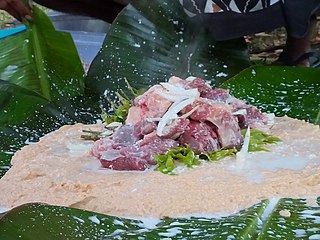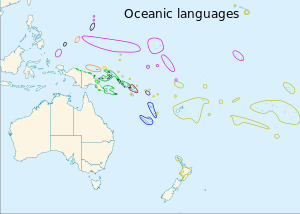
The approximately 450 Oceanic languages are a branch of the Austronesian languages. The area occupied by speakers of these languages includes Polynesia, as well as much of Melanesia and Micronesia. Though covering a vast area, Oceanic languages are spoken by only two million people. The largest individual Oceanic languages are Eastern Fijian with over 600,000 speakers, and Samoan with an estimated 400,000 speakers. The Gilbertese (Kiribati), Tongan, Tahitian, Māori and Tolai languages each have over 100,000 speakers. The common ancestor which is reconstructed for this group of languages is called Proto-Oceanic.
The nine South Vanuatu languages form a family of the Southern Oceanic languages, spoken in Tafea Province of Vanuatu.
The Central Vanuatu languages form a linkage of Southern Oceanic languages spoken in central Vanuatu.

The Republic of Vanuatu has the world's highest linguistic density per capita. Despite being a country with a population of less than 300,000, Vanuatu is home to 138 indigenous Oceanic languages.

North Efate, also known as Nakanamanga or Nguna, is an Oceanic language spoken on the northern area of Efate in Vanuatu, as well as on a number of islands off the northern coast – including Nguna, and parts of Tongoa, Emae and Epi.
The North Vanuatu languages form a linkage of Southern Oceanic languages spoken in northern Vanuatu.
Kiai is an Oceanic language spoken by about 450 people in the central highlands of Espiritu Santo island, in Vanuatu.
The North-Central Vanuatu languages are a linkage of Oceanic languages spoken in Vanuatu and New Caledonia. It was proposed by Clark (2009), who reconstructed the proto-language of the entire group, viewed here as an early, mutually-intelligible chain of dialects. but this is not accepted by Lynch (2018).
Mwesen is an Oceanic language spoken in the southeastern area of Vanua Lava Island, in the Banks Islands of northern Vanuatu, by about 10 speakers.
Lenakel, or West Tanna, is a dialect chain spoken on the western coast of Tanna Island in Vanuatu.

Laplap is the national dish of Vanuatu. Laplap is prepared by grating breadfruit, bananas, taro or yam roots into a vegetable paste. The paste is then wrapped in banana leaves and cooked in an underground stone oven, with fresh coconut cream. Meats like pork, beef, chicken or flying fox can be added.
The Malakula languages are a group of Central Vanuatu languages spoken on Malakula Island in central Vanuatu. Unlike some earlier classifications, linguist and Oceanic languages specialist John Lynch (2016) considered the Malakula languages to form a coherent group.
The Espiritu Santo languages are a group of North Vanuatu languages spoken on Espiritu Santo Island in northern Vanuatu. Tryon (2010) considers the Espiritu Santo languages to be a coherent group.
The Torres–Banks languages form a linkage of Southern Oceanic languages spoken in the Torres Islands and Banks Islands of northern Vanuatu.
Dalkalaen is a Central Vanuatu language spoken by about 1,000 people on the southwestern tip of Ambrym Island, Vanuatu.
Kene is an Espiritu Santo language of Vanuatu with 300 speakers.
Retlatur is an Espiritu Santo language of Vanuatu. There are about 100 speakers in Tanovusivusi village of southern Santo Island.
Rutan is a Malakula language of Vanuatu.
Alovas is a Malakula language of Vanuatu.
The Narave or Naravé pig is a type of domestic pig native to northern Vanuatu. Navare pigs are pseudohermaphrodite (intersex) male individuals that are kept for ceremonial purposes.




